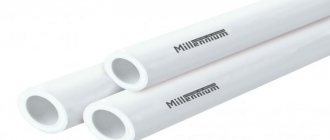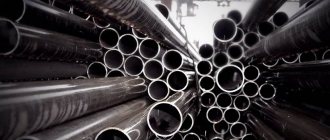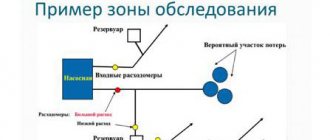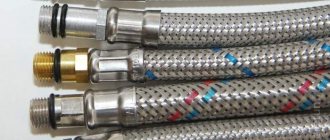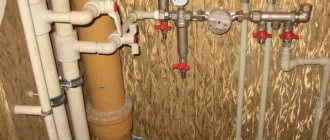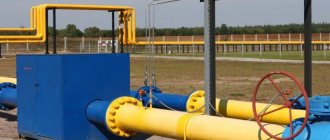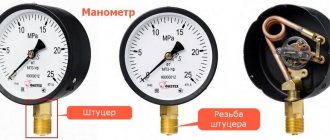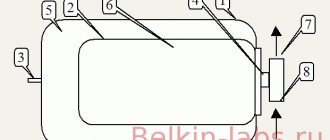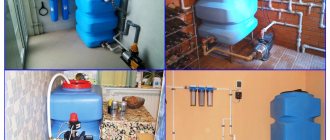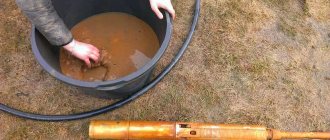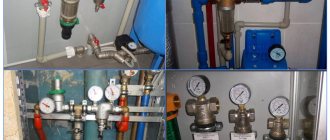When laying water supply networks in a country house or mini-hotel, the permeability of the pipes must be taken into account. It shows the maximum volume of liquid passing through the main network during a specific time interval. This allows you to find out how much moisture will flow away when the taps are open, and compare the obtained value with the expected water consumption of the residents of the house. The easiest way to calculate water flow is by pipe diameter and pressure, since these indicators are easy to find out.
Determination of daily expenses for household needs of the population
The average daily water consumption for household needs of the population (Qav) is determined:
Qср day = qср • N /1000; m3/day, (2-1)
Where:
qср - norm of water consumption per person (Table 2.1), l/person•day. ;
N is the number of residents in the locality, people.
Table 2.1. Standards of water consumption for household and drinking needs per resident
Information on the number of residents in a locality (N) can be obtained from local authorities. In this case, it is advisable to use the results of the population census. If such information is not available for any reason, then the population size is determined:
N = F • n ; (2-2)
Where:
F is the area of the residential zone, hectares;
n is the population density in a populated area or area of a populated area for which the water supply system is calculated, people/ha.
Water from the water supply network is consumed unevenly throughout the year due to changes in the population's lifestyle and the seasonality of some water consumption.
To characterize the unevenness of water withdrawal from the urban network, the concept of the daily unevenness coefficient is introduced. It takes into account the lifestyle of the population, the operating hours of enterprises, the degree of improvement of housing, changes in water consumption by season of the year and days of the week, etc.
The coefficient of daily unevenness (maximum) (Ksut.max) is defined as the ratio of the maximum daily flow to the average daily (for the year) and is taken within the range of 1.1 - 1.3.
The coefficient of daily unevenness (minimum) (Ksut min) is defined as the ratio of the minimum daily flow rate to the average daily flow rate and is taken within the range of 0.7 - 0.9.
The value of the probable estimated water consumption per day of maximum (maximum daily consumption, Qmax day) and minimum (minimum daily consumption, Qday min) is determined by the formulas:
Q day max = K day max• Qcr day, m3/day; (2-3)
Q day min = K day max• Qav day, m3/day. (2-4)
During the day, water is also consumed unevenly by the population. The distribution of water consumption by residents by hour of the day is determined by the coefficient of hourly unevenness.
The coefficient of hourly unevenness (maximum, K hour max) is the ratio of the maximum hourly flow rate to the average hourly flow rate (per day).
Hourly unevenness coefficient (minimum, Kh min,) - the ratio of the minimum hourly consumption to the average hourly.
K hour min =α min • Вmin. (2-5)
K hour max = αmax • Bmax. (2-6)
where: α is a coefficient that takes into account the degree of improvement of buildings, the operating mode of enterprises and other local conditions: α max = 1.2 - 1.4; α min = 0.4 - 0.6.
β is a coefficient that takes into account the number of residents in a locality.
The value of coefficient β is determined according to table 2.4 or by the formula:
β = 1 +√N (2-7)
where: N is the number of residents in a locality or region, thousand people.
Estimated hourly flow rates (m3/hour) are determined using the following formulas:
Q hour max = K hour max •Q avg day /24. (2-8)
Q hour min = K hour min •Q avg day/24. (2-9)
Determination of estimated costs for watering streets and green spaces
Water consumption for watering streets and green spaces is determined by the formula:
Qpol = 10 N • q p.sp. • F, m3/day. (2-10)
where: q p. ud - specific consumption for watering streets or green spaces, l/m2;
N is the number of waterings per day;
F is the area of irrigated streets or green spaces, hectares.
Table 2.5.
The value of the coefficient β depending on the population
The areas of streets and green spaces are determined directly according to the city plan or approximately in accordance with the planning standards of populated areas.
For irrigation, water is used from the city water supply, natural or artificial reservoirs, and storage tanks.
The amount of drinking quality water taken from the city water supply for watering streets and green spaces is determined in each case specifically, depending on local conditions and is established by local authorities. As a rough estimate, we can assume that 40% of the total volume of irrigation water is taken from the city water supply. And only this water is taken into account when calculating the city’s water distribution networks.
Of the total volume of drinking quality water taken from the city water supply network for watering streets and green spaces, 20% is spent on manual watering, the remaining 80% on mechanized watering.
The irrigation regime and the volumes of drinking water that are allowed to be used for irrigation are set by local governments. If such information is not available, the watering schedule can be set as follows:
- mechanized: 60% - from 21 to 4 hours;
15% - from 4 to 7 o'clock;
25% - from 17 to 21 hours.
- manual watering: 30% - from 4 to 7 o'clock;
40% - from 13 to 15 hours;
30% - from 20 to 22 hours.
Green spaces on the territory of an industrial enterprise are usually watered with process water.
For this purpose, special watering networks are installed.
By meter
When meters are installed, readings are taken separately. Individual metering devices for cold and hot water differ in color design. For the former, the body is painted blue, for the latter – red.
Sequence of readings
The readings must be taken between the 20th and 25th of the current month, subject to the following sequence of actions:
- write down the current number of cubic meters, excluding the leading zeros and the fractional component;
- Subtract the value taken last month from the recorded value.
Taking readings from a five-roller counter
Taking readings from an eight-roller counter
For further calculation, the obtained result is multiplied by the tariff size, taking into account wastewater disposal (if there is a centralized sewerage system).
The consumer must promptly submit meters for verification to a licensed organization. To do this, you must inform the resource provider about the need for this activity. The water meter will be removed and the corresponding report will be drawn up. During the time the device is being verified, payment is calculated based on the average indicators for the previous six months.
We recommend: Reasons why the electricity meter may be buzzing
Meter readings with an overdue verification period are considered invalid.
Payment calculation
An example of a calculation for a situation similar to that indicated above, when considering determining the amount of payment according to standards. Over the course of a month, the family consumed 9 cubic meters of cold water and 2 cubic meters of hot water.
For cold water you must pay: 9 ×79.73 (tariff for cold water) = 717.57 rubles.
Payment amount for DHW: 2 × 199.84 (tariff for DHW) = 399.68 rubles.
Attention! Each region, territory or republic has different tariffs. You can find out the tariff in your area on the official website of the utility service provider or from your receipt.
As you can see, with individual metering devices installed, the bill amount will be significantly lower, especially compared to payment according to standards when using increasing factors. The use of coefficients that increase the payment amount is connected with the purpose of attracting consumers’ interest in installing water meters. In this case, the owner will pay only for the resources actually consumed.
If the consumer promptly transmits meter readings to the utility organization and regularly pays the bills presented on time, he should not be afraid of misunderstandings with the resource supplier. Otherwise, problems and financial losses cannot be avoided.
Water consumption for fire extinguishing needs
Fire fighting, as a type of water consumption, is of a specific nature, since fire is a random event. But the water supply system must at any time provide the required flow both for the needs of the population and industrial enterprises, and for fire fighting.
Water supply networks of populated areas and industrial enterprises are designed in such a way that they can simultaneously supply the population with water and perform the functions of a fire-fighting water supply system.
The calculation of the number of simultaneous fires in a populated area also includes fires at industrial enterprises. In this case, the estimated costs include the corresponding costs for fire extinguishing at these enterprises.
When determining water consumption to extinguish a fire in a residential or public building, you should use the data in Table 2.6
Table 2.6. Water consumption to extinguish one fire depending on the volume of the building
Water consumption for external fire extinguishing of buildings with a height or volume exceeding those indicated in Table 2.6, as well as public buildings with a volume of over 25,000 m3 with large crowds of people (shopping centers, entertainment enterprises, etc.) must be accepted and agreed upon in the prescribed manner.
Water consumption for external fire extinguishing of one-two-story industrial buildings and warehouses with a height from the floor to the bottom of horizontal load-bearing steel structures up to 18 m is taken according to tables 2.7 and 2.8.
Table 2.7. Water consumption for extinguishing fires in industrial buildings up to 60 meters wide, depending on the volume of buildings and the fire hazard category of production.
For buildings equipped with sprinkler installations, the water consumption for powering the sprinklers should be taken in addition to the total consumption for fire extinguishing. The maximum period for restoring the emergency fire reserve in containers should be no more than:
- 24 hours - in populated areas and at industrial enterprises with production facilities classified as fire hazard categories A, B, C;
- 36 hours - at industrial enterprises with production facilities classified as fire hazard categories G, D;
- 72 hours - in rural areas and agricultural enterprises.
Table 2.8.
Water consumption for extinguishing fires in industrial buildings more than 60 meters wide, depending on the volume of buildings and the fire hazard category of production. During the period of replenishing the fire-fighting water supply, it is possible to reduce the water supply for household needs of the population to 70%, and supply water for production according to an emergency schedule.
Features of water supply rationing in rural areas
The supply of water to private houses in rural areas is subject to rationing in the case of centralized water supply to consumers by utility companies. It is possible to assign a separate payment if there is a water stand on a public street.
We recommend: What to do if you mix up the phase on the electricity meter
It must be taken into account that water is additionally consumed for watering the garden, therefore, in the appropriate season, if there is no water meter in a private house, a separate fixed amount is assigned for these needs.
If residents of the private sector do not provide water supply centrally, including installation and maintenance of systems, utility standards are not applicable in this situation.
Water consumption for the needs of the enterprise
Water consumption for household needs of industrial workers and showers
Water for domestic needs of workers at industrial enterprises is consumed extremely unevenly.
The hourly unevenness coefficient for “hot” workshops is -2.5, for “cold” ones - 3.0. The total water consumption per shift is determined by:
q cotton = q o.i • N r.i / 1000, m3/shift, (2-11)
where: q o. I. - water consumption for the household needs of a worker in a “cold” or “hot” workshop, l/person. shift;
Nр. I. - number of workers per shift.
The number of simultaneously operating shower nets (Nd.s.) is determined by the number of people served by one shower net, depending on the type of production processes in accordance with the data in Table 2.9.
N d.s. = N r. /n o. pp., (2-12)
where: Nр. — number of workers taking showers;
no.s. — estimated number of people per shower net.
Table 2.9. Estimated number of people per shower net for different sanitary characteristics of production
Water consumption for a shower is determined by the formula:
Qd.s.=Nd.s. • qd.o./1000 = Nd.s. • 0.375 (m3/hour) (2-13)
Workers from the previous shift take a shower during the first hour of the next one.
Water consumption for production needs
Water for production needs can be taken from the city water supply (drinking water), from surface or underground sources (process water).
For enterprises that require large quantities of water, their own water supply systems are installed (metallurgy, energy, chemical plants, oil refining complexes). When calculating urban water supply networks, the consumption of water supplied to an industrial enterprise is taken into account, only of drinking quality.
Water consumption for production needs is determined as the product of norms or specific water consumption by the volume of products produced, the number of technological operations or the duration of the technological process.
The mode of water consumption by an industrial enterprise is determined by production technology and must be agreed upon with local authorities or the water inspectorate. If there are restrictions on the selection of water from the water supply network at the hour of maximum water consumption, a water supply unit is installed on the industrial site, which includes a clean water reservoir and a pumping station, and sometimes disinfection units.
In case of high water consumption and significant coefficients of unevenness, enterprises install storage tanks, which are filled during the hours of minimum water consumption by the populated area. A water flow meter must be installed at the entrance to an industrial enterprise.
Factors affecting throughput
The main factor used to calculate the pipeline system is throughput. This indicator is influenced by many different parameters, the most significant of which are:
- pressure in the existing pipeline (in the main network, if the pipeline under construction will be connected to an external source). The calculation method taking into account pressure is more complex, but also more accurate, since an indicator such as throughput, that is, the ability to pass a certain amount of water in a certain unit of time, depends on pressure;
- total pipeline length. The larger this parameter, the greater the amount of losses that appears during its use and, accordingly, to avoid a pressure drop it is necessary to use pipes of larger diameter. Therefore, this factor is also taken into account by specialists;
- the material from which the pipes are made. If metal pipes are used to construct a water pipeline or other main line, then the uneven internal surface and the possibility of gradual clogging with sediment contained in the water will lead to a decrease in throughput and, accordingly, a slight increase in diameter. When using plastic pipes (PVC), polypropylene pipes, the possibility of clogging with deposits is practically eliminated. Moreover, the inner surface of plastic pipes is smoother;
Reduced pipe capacity due to deposits
- pipe section. Based on the internal cross-section of the pipe, you can independently make a preliminary calculation.
There are other factors that are taken into account by experts. But for this article they are not significant.
Determination of daily water consumption in a populated area
The consumption of water consumed by a settlement includes expenses: household needs of the population, household needs and showers of workers of industrial enterprises, technological costs of industrial enterprises, watering of streets and green spaces. Accounting is carried out both for individual water consumers and for water of varying quality (drinking, technical, taken from a source, etc.).
The water consumption of a populated area is determined both on the day of maximum water consumption and on the daily average.
Based on materials: Water supply: textbook / N. I. Kulikov [et al.]. – Novosibirsk: TsSRNI LLC, 2021. – 704 p.
